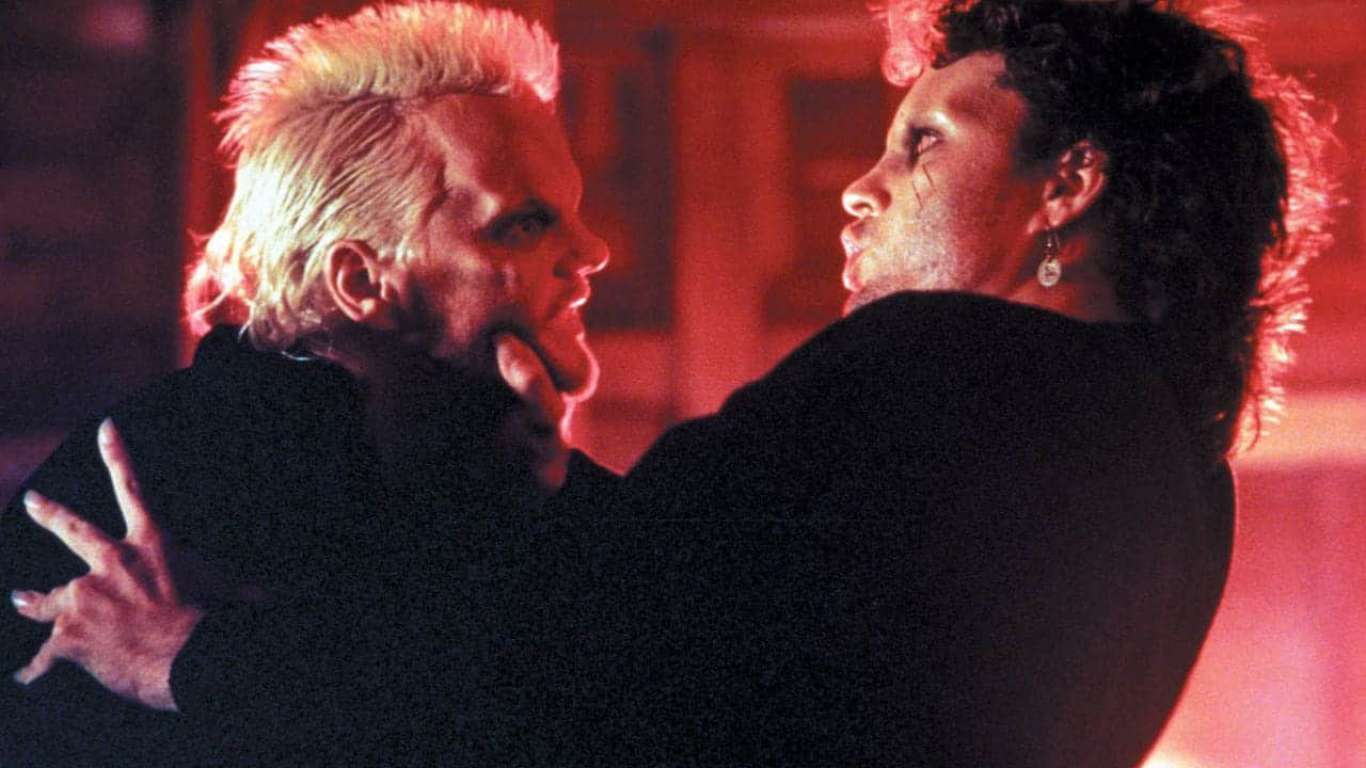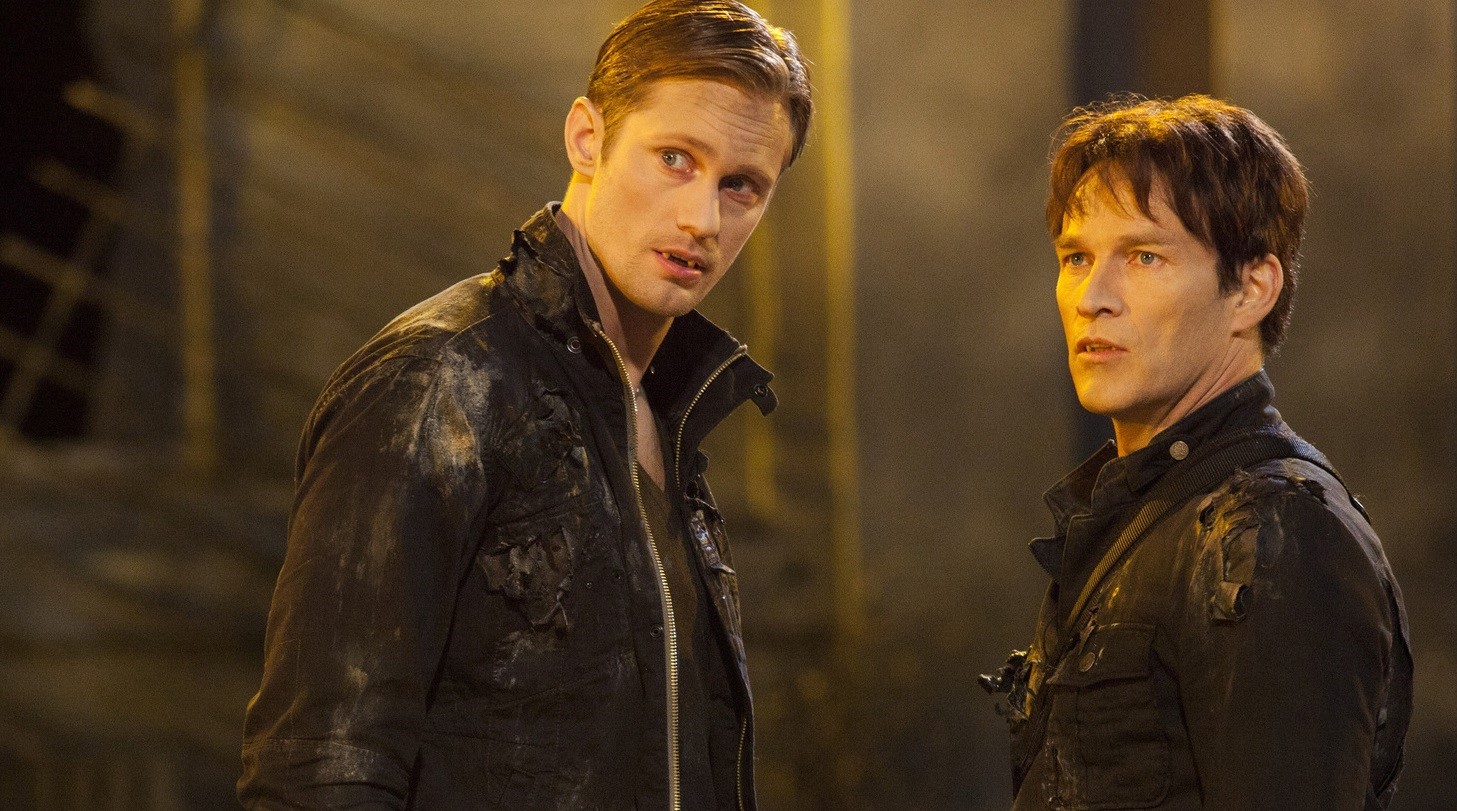Interview with the Vampire hit bookstore shelves 45 years ago, on May 5, 1976. Although first-time author Anne Rice’s novel was only a cult hit at first, its influence on vampire fiction slowly grew over the years. By the time the first sequel, The Vampire Lestat, hit nearly a decade later, the book had become a paperback smash. So much so that the second and third novels in the series became instant bestsellers.
Interview with the Vampire wasn’t the first major portrayal of a sympathetic vampire in pop culture. The television series Dark Shadows already accomplished this, as did Marvel Comics’ Morbius. But it did introduce a formula that would inspire many over the next several decades: two hunky male vamps taking center stage, one remorseful and one relishing in evil. It’s a relationship usually soaked in conflict and homoerotic subtext.
The Vampires Lestat and Louis: Trendsetters

Ballantine Books
Interview with the Vampire tells the story of Louis de Pointe du Lac, a plantation owner in antebellum New Orleans who falls sway to a European vampire named Lestat. Louis hates his supernatural essence and fights against his dark impulses. Meanwhile, the cruel, fair-haired Lestat rejoices in draining the life around him. The two have an intense love/hate relationship, one made even worse when they sire a vampire, Claudia, together. Although the two vampires essentially serve as her parents, as the decades roll on she becomes an adult in a child’s body. By then, her relationship with Louis (and to a certain extent Lestat) becomes more romantic in nature.

Warner Bros.
The Lestat/Louis template became a huge influence on vampire fiction, particularly on film and TV. In the decades following Interview’s publication, the idea of a pair of sexy male vamps, one repentant and one not (and one usually blonde and one usually dark-haired), dominated screens. Often, the homoeroticism of Rice’s original novel was minimized. But it was always there, if you looked close enough. Here are four prominent vampires from pop culture that took the Lestat/Louis template for male vampires and just ran with it.
The Lost Boys (1987)

Warner Bros.
The Lost Boys was maybe the first time we saw the Lestat/Louis template play out in a movie. Of course, being a mainstream horror film aimed at American teenagers, the homoeroticism of the Lestat/Louis relationship was pretty sublimated. (This despite the film’s director, Joel Schumacher, being a gay man himself.) But the subtext was all there still, dialed down enough as to not freak out Reagan-era moviegoers.
In the film, Santa Carla, California’s predominant vampire is David (Kiefer Sutherland), a blonde-haired, rock-‘n’-roll-style vamp. This sarcastic and unrepentant bloodsucker springs forth straight from the Lestat mold. He seduces Michael (Jason Patric), a broody teenager who is very much the film’s version of Louis. The blood exchange is very chaste in The Lost Boys, however, as David gives Michael his blood in a bottle. I guess they figured average mall-going teens would revolt at David actually biting Michael. Nevertheless, Michael hates his new vampire self, even if he never gets around to killing anyone.

Warner Bros.
Though toned-down, the sexual tension between David and Michael is pretty palpable. Far more so than the sexual tension between Michael and the female vampire acolyte Star (Jami Gertz). This holds true even though Michael and Star get an actual sex scene. Star is ultimately the Claudia of this movie, a vampire “child” of David’s that he and Michael come to blows over. As a teen horror-comedy, The Lost Boys doesn’t dive deep into the themes in Rice’s novel. But according to the film’s own director on his DVD commentary, the novel was definitely an influence when making the film.
Buffy the Vampire Slayer (1997-2003)

Twentieth Century Television
The next big Lestat/Louis dynamic in pop culture takes form between vampires Angel and Spike in Buffy the Vampire Slayer. By the time Buffy premieres in 1997, the Interview with the Vampire movie had already come out. So one can make the argument the film was as much an influence as the novel. Much like Louis, Buffy’s Angel (David Boreanaz) hates his own undead nature. He broods endlessly about the suffering he’s caused in his centuries-long existence. And much like Louis, he’s dark-haired and easy on the eyes. To be fair, Angel is far more proactive in making up for his past sins than Louis ever was.
In season two, the show introduces us to Spike (James Marsters). He’s a bleach-blonde vamp and the complete opposite of Angel. Like Lestat, he has a rockstar swagger and a sarcastic attitude to go with it. He’s pretty much shown as a remorseless killer at first, whose only intentions are to feed on Sunnydale and kill the Slayer. When he encounters Angel, he even accuses the so-called “vampire with a soul” of playing up the “ whole Anne Rice routine.” Buffy deviated from the Lestat/Louis formula in revealing that Angel was actually Spike’s mentor and “grandsire”—not the other way around.
Angel (1999-2004)

20th Century Television
As Buffy continued and spun off Angel, the relationship between the two vampires took on a more Lestat/Louis vibe. Throughout the shows, it is clear that Angel and Spike hate each other. But we learn there was love between them once too. Several flashback episodes illustrate this twisted relationship. Much like Lestat in Rice’s novels, Spike’s unrepentant evil ways ultimately give way to a sympathetic portrayal.
Another similarity to the Lestat/Louis/Claudia triangle, much of Angel and Spike’s animosity towards one another centers around their mutual obsession with a woman. First the vampire Drusilla (Juliet Landau), then later Buffy Summers herself (Sarah Michelle Gellar). As for the Lestat/Louis homoeroticism, It was only in the final season of Angel that Spike admits he and Angelus were actually intimate “that one time.” Took them long enough, but they got there eventually.
True Blood (2008-2014)

HBO
HBO’s hit series True Blood was based on an entirely different series of vampire novels that just so happened to also take place in the Deep South. Charlaine Harris’ Southern Vampire Mysteries might have provided the blueprint for the series, but Alan Ball’s show still mined some Lestat/Louis vibes for its two central leads. Bill Compton (Stephen Moyer) is a repentant Louisiana vampire who broods over all the killing he’d done in 19th century America. Yes, he’s this series’ version of Louis. And like Louis, he’s also an attractive brunette gentleman.
The Lestat of the series is Viking vamp Eric Northman (Alexander Skarsgård). He’s yet another blonde, sardonic vamp with a sneering attitude. Unlike in the Lestat/Louis relationship, Eric is not Bill’s maker, however, or even a mentor. That said, the two have a history going back several decades. As is now formula, the two undead gentlemen’s animosity towards one another presumably centers around a young woman they are both equally obsessed with. In True Blood, it’s psychic waitress Sookie Stackhouse (Anna Paquin).

HBO
But regardless of Sookie, all that sexual tension between the two male vamps is evident to everyone watching. Heck, it’s obvious even to the characters in the show. At one point, another True Blood character tells the two they “should just f*** already.” (This never happens, sadly). Much like in Rice’s novels, Eric Northman ultimately shreds a lot of his “evil” persona and becomes the favorite of True Blood devotees. Meanwhile, Bill starts looking progressively worse on a moral level as the series rolls on.
Interestingly, Alexander Skarsgård quickly became the fans’ top choice to play Lestat in a new film or TV version of Rice’s novels. Talk about typecasting.
The Vampire Diaries (2009-2017)

Warner Bros. Television
Finally, we get to CW’s hit series The Vampire Diaries. This debuted around the same time that Twilight was thriving as a cultural phenomenon. But it owes more to Rice’s depiction of vampires than it does to Stephenie Meyer’s. This series is also where the Lestat/Louis parallels become more superficial. For starters, the series’ two lead vamps, Stefan and Damon Salvatore (Paul Wesley and Ian Somerhalder), are actual brothers. Stefan is broody and remorseful, while Damon is the polar opposite. But the homoerotic tension is mostly nonexistent, since the two are siblings.
At this point, the series is playing off the previous shows and movies that Interview influenced, more than Interview itself. It’s clearly trying to mimic the Angel/Spike/Buffy triangle that worked so well a decade prior. But unlike Buffy and True Blood, the woman at the center of the tug of war between the two male vamps eventually becomes a vampire herself. This is far more Rice-ian in nature than the previous two series. We even see Damon reading one of Rice’s novels; he gives her a nod as “the only writer who gets it.” It was nice of the producers to acknowledge the template for the show’s leads, even if, by this point, it had become very watered down.
It’s all coming back to the beginning now. Anne Rice’s Vampire Chronicles is coming soon to AMC as a TV series. Meaning we’re about to see the Lestat/Louis dynamic play out on our screen all over again. It’ll no doubt influence a whole new generation of vampires on screen. Time is a flat circle, especially when you’re immortal.